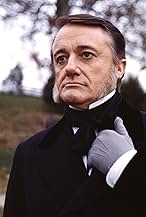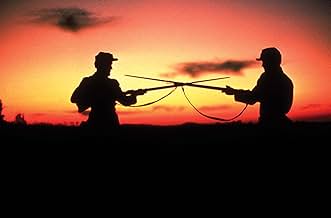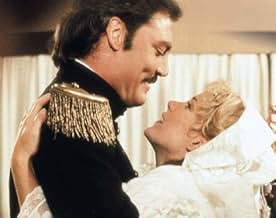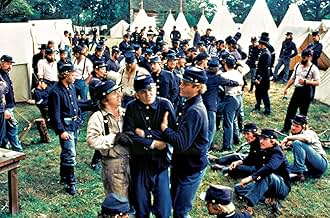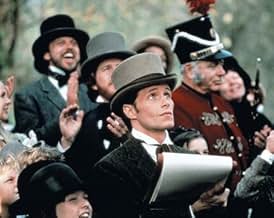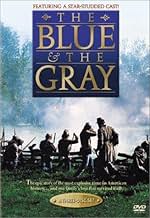America just before and during the Civil War, as seen through the eyes of an artist correspondent.America just before and during the Civil War, as seen through the eyes of an artist correspondent.America just before and during the Civil War, as seen through the eyes of an artist correspondent.
- Nominated for 4 Primetime Emmys
- 2 wins & 4 nominations total
Browse episodes
Featured reviews
This miniseries shows the war primarily through the eyes of a Virginian who wants to witness history but cannot commit to either side of the conflict. His new-found profession of journalism allows him to participate as a neutral observer. He is surrounded by relatives and friends on both sides, and the miniseries shows events through their eyes as well.
The human side of the war is stressed, and it excellently portrays the toll the conflict took on families.
Many of the subplots are taken from Civil War historian Bruce Catton's final work, "Reflections On The Civil War." However, none of the people in the book, including the real John Geyser, appear in the miniseries. Rather, observations made in the book are woven around the main storyline as supplementary material.
Most of the military aspects of the miniseries are laughable and bear little resemblance to reality. Due to the miniseries being done on a miniseries budget we see none of the grand scale evident in "Gettysburg" or "Glory."
Stacy Keach gives a terrific performance as Jonas Steele, the Federal special operations agent. We see from his performance a little of the decentralized, more personalized ways in which intelligence gathering and other non-standard military operations were conducted in the nineteenth century.
The miniseries ran for over six hours on CBS in 1982, but well over an hour was cut for the two-cassette video release. Get the whole treatment if you can.
The human side of the war is stressed, and it excellently portrays the toll the conflict took on families.
Many of the subplots are taken from Civil War historian Bruce Catton's final work, "Reflections On The Civil War." However, none of the people in the book, including the real John Geyser, appear in the miniseries. Rather, observations made in the book are woven around the main storyline as supplementary material.
Most of the military aspects of the miniseries are laughable and bear little resemblance to reality. Due to the miniseries being done on a miniseries budget we see none of the grand scale evident in "Gettysburg" or "Glory."
Stacy Keach gives a terrific performance as Jonas Steele, the Federal special operations agent. We see from his performance a little of the decentralized, more personalized ways in which intelligence gathering and other non-standard military operations were conducted in the nineteenth century.
The miniseries ran for over six hours on CBS in 1982, but well over an hour was cut for the two-cassette video release. Get the whole treatment if you can.
This is such a good movie mainly due to the lack of bias and multiple story lines which keep you hooked throughout the extensive length of the film. I thought that the film was, although of course not the greastest of civil war films, it definitely desearves nothing but good reviews. I saw this movie when i was visiting Utah with family and i had to live in a trailer with my brother and his friend for a few days and all we had was a DVD player and a few movies and some paper and pens. So when we finally decided to watch what seemed like a boring war movie...we never wanted to leave the trailer. Even when invited to go horse-back riding by some neighborhood girls whom my brother had been eyeing. the movie was completely captivating. Everyone should definitely see The Blue and the Gray at LEAST once.
This was a very good film about the Civil War. It showed the mindset of people living in the south during that era; how they were swayed into entering a futile and dangerous undertaking. The agony of war was shown at its worst, depicting the loss of the combatants as well as bystanders. Any war is horrible, but the war between the states is more so because of its utter uselessness. The waste of life and material should never have been allowed to happen. I recommend this movie; the action sequences are dramatic and well done, however, I felt some of the scenes seemed a bit underpopulated.
Released in 1982 and directed by Andrew V. McLaglen, "The Blue and the Gray" covers the Civil War era from 1859-1865 focusing on two related families: The Geysers, farmers from Charlottesville, Virginia, and the Hales from Gettysburg, Pennsylvania, who own a newspaper. John Geyser (John Hammond) leaves Virginia to get a job as a sketch artist at the Hale's newspaper in Gettysburg. When war breaks out after the Southern states secede from the Union, John covers the war for Harper's Weekly.
MAIN CAST includes Stacy Keach as a Pinkerton-turned-Union-officer who romances John's cousin (Julia Duffy); Gregory Peck as Lincoln; Kathleen Beller as an aristocrat-turned-nurse; Dan Shor & Michael Horton as John's brother; Rip Torn as General Grant; and Lloyd Bridges & Colleen Dewhurst as Mr. and Mrs. Geyser. These are just the principle characters; there are scores of others (Robert Vaughn, Geraldine Page, Warren Oates, Robert Symonds, etc.).
I prefer "The Blue and the Gray" to the similar "North and South" (Books I & II, 1985-86) because it's more streamlined and less soap opera-y. Director McLaglen had decades of experience by this this time with both TV shows and films, including a few notable Westerns, like "Bandolero!" (1968) and "Chisum" (1970); in fact, his "Shenandoah" (1965) was a Civil War 'Western.'
The first half is great, but the second half flounders a bit and includes some cheesy plot gimmicks, like the mad slasher Confederate officer and John mistaking his babe (the nurse) supposedly making out with the Union stud (Keach). The 'floundering' includes some abrupt shifts, like from the Battle of Vicksburg (July, 1863) to the Battle of the Wilderness (May, 1864), which can likely be explained by cuts from the original mini-series. If you watch the longer version you probably won't encounter this problem.
What I like best about this "miniseries" (i.e. long movie) is that, despite some elements of TV-production cheese (e.g. the two Union & Confederate deserters' almost goofy meeting in the woods), the film takes you back in time to the Civil War era and provides a quality picture of what it was like.
Some of the notable events covered include: The Battle of Bull Run, Army camp life, dysentery in the camps, cowards in battle and the branding thereof, balloon reconnaissance, fraternizing with the enemy after hours, brother vs. brother, the Gettysburg Address, the siege of Vicksburg and the desperation thereof (e.g. the Caves), prisoner-of-war camps (Elmira), Lee's surrender and Lincoln's death. Yes, some key events are off-screen (e.g. the Battle of Gettysburg and Lincoln getting shot), but that's the nature of the beast with a TV-budget and an overview-styled story. Lastly, Keach shines as one of the main protagonists, easily one of his best rolls, and Duffy is a delight.
The film runs 296 minutes (4 minutes shy of 5 hours), with the original 3-part miniseries running 381 minutes. It was shot entirely in Arkansas (Fort Smith, Eureka Springs, Fayetteville, Van Buren & Prairie Grove Battlefield State Park). The script was written by John Leekley & Ian McLellan Hunter based on Bruce Catton's material.
GRADE: B
MAIN CAST includes Stacy Keach as a Pinkerton-turned-Union-officer who romances John's cousin (Julia Duffy); Gregory Peck as Lincoln; Kathleen Beller as an aristocrat-turned-nurse; Dan Shor & Michael Horton as John's brother; Rip Torn as General Grant; and Lloyd Bridges & Colleen Dewhurst as Mr. and Mrs. Geyser. These are just the principle characters; there are scores of others (Robert Vaughn, Geraldine Page, Warren Oates, Robert Symonds, etc.).
I prefer "The Blue and the Gray" to the similar "North and South" (Books I & II, 1985-86) because it's more streamlined and less soap opera-y. Director McLaglen had decades of experience by this this time with both TV shows and films, including a few notable Westerns, like "Bandolero!" (1968) and "Chisum" (1970); in fact, his "Shenandoah" (1965) was a Civil War 'Western.'
The first half is great, but the second half flounders a bit and includes some cheesy plot gimmicks, like the mad slasher Confederate officer and John mistaking his babe (the nurse) supposedly making out with the Union stud (Keach). The 'floundering' includes some abrupt shifts, like from the Battle of Vicksburg (July, 1863) to the Battle of the Wilderness (May, 1864), which can likely be explained by cuts from the original mini-series. If you watch the longer version you probably won't encounter this problem.
What I like best about this "miniseries" (i.e. long movie) is that, despite some elements of TV-production cheese (e.g. the two Union & Confederate deserters' almost goofy meeting in the woods), the film takes you back in time to the Civil War era and provides a quality picture of what it was like.
Some of the notable events covered include: The Battle of Bull Run, Army camp life, dysentery in the camps, cowards in battle and the branding thereof, balloon reconnaissance, fraternizing with the enemy after hours, brother vs. brother, the Gettysburg Address, the siege of Vicksburg and the desperation thereof (e.g. the Caves), prisoner-of-war camps (Elmira), Lee's surrender and Lincoln's death. Yes, some key events are off-screen (e.g. the Battle of Gettysburg and Lincoln getting shot), but that's the nature of the beast with a TV-budget and an overview-styled story. Lastly, Keach shines as one of the main protagonists, easily one of his best rolls, and Duffy is a delight.
The film runs 296 minutes (4 minutes shy of 5 hours), with the original 3-part miniseries running 381 minutes. It was shot entirely in Arkansas (Fort Smith, Eureka Springs, Fayetteville, Van Buren & Prairie Grove Battlefield State Park). The script was written by John Leekley & Ian McLellan Hunter based on Bruce Catton's material.
GRADE: B
I did not see this movie when it was shown as a mini-series.I happened to like this movie because it gave a simple portrayal of what it might have been like to be a family during this period and having to face the problem of a family that was divided in its loyalties . I thought the makers of this movie followed the history of the period and gave a good presentation of the issues that the people had to deal with at the time. Of course it cannot compare to the recent Civil War Movies or even the Ken Burns series . Given the time that it was made I think it was a good portrayal of the period.
My only fault with the movie was the fact that it seemed to put the fall of Vicksburg after the Gettysburg Address. I did not understand how this was allowed to happen given the fact that it seemed to be based on Bruce Catton's work. Can anyone explain this?
My only fault with the movie was the fact that it seemed to put the fall of Vicksburg after the Gettysburg Address. I did not understand how this was allowed to happen given the fact that it seemed to be based on Bruce Catton's work. Can anyone explain this?
Did you know
- TriviaSome filming took place at Prairie Grove Battlefield State Park in Arkansas. The film crew built a false side onto a historic building there, then blew it off for a special effect, assuring the State park officials that no harm would come to the building. The explosion was larger than promised, damaging the historic house's structure.
- GoofsWhen John Brown is hanged for the uprising at Harper's Ferry, the apple trees are in full blossom. John Brown was hanged on 2 December 1859.
- Quotes
Abraham Lincoln: It's well known that the more a man speaks, the less he's understood.
- ConnectionsReferenced in Saturday Night Live: Drew Barrymore/Squeeze (1982)
- SoundtracksRock of Ages
Lyrics by Augustus Montague Toplady (as Augustus M. Toplady)
Music by Thomas Hastings
- How many seasons does The Blue and the Gray have?Powered by Alexa
Details
Contribute to this page
Suggest an edit or add missing content


